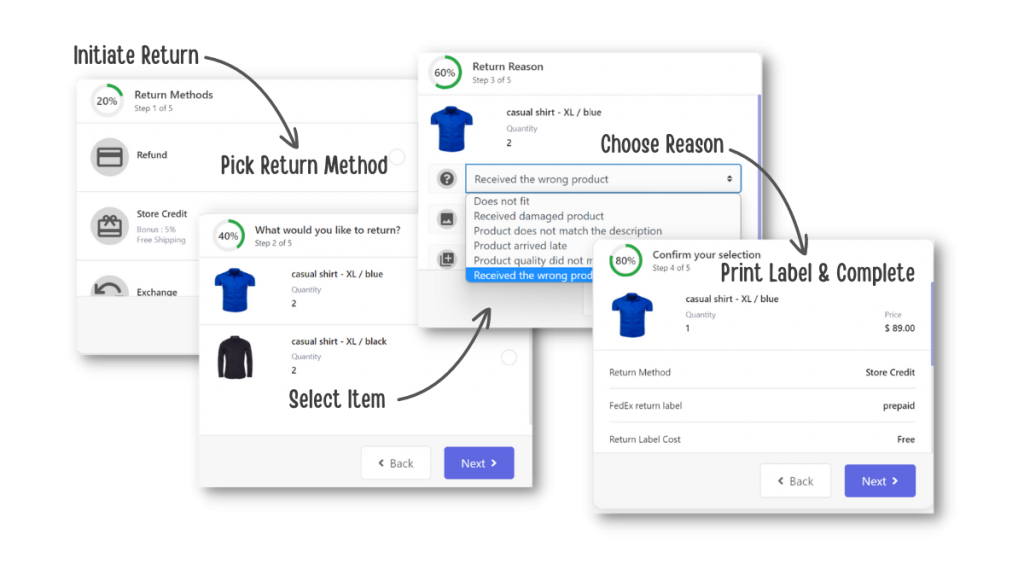Not everything is A-OK after your customers complete their purchase with your e-commerce store and are awaiting their orders. It is at this stage that even the ones who are most excited to shop with your store can get disappointed.
Why? Because it is at this point where the doubt starts to creep in, and the customer starts wondering if they made the right choice. This phenomenon is called post-purchase dissonance.
For businesses, it’s a nightmare. A customer questioning their purchase is one step away from a return, a bad review, or worse, never shopping with you again. But here’s the good news—you can stop this from happening.
The right post-purchase strategies can reassure customers, reinforce their choices, and turn hesitation into long-term brand loyalty. Let’s understand what post-purchase dissonance really is, why it happens, how to spot it, and most importantly, how to eliminate it before it impacts your bottom line.
What is Post-purchase Dissonance?
Post-purchase dissonance is simply buyer’s remorse that happens, particularly in online purchases. It is a sense of regret for the customer, who feels they’ve made a hasty or wrong decision after completing a purchase with an e-commerce business.
Customers who have experienced post-purchase dissonance may frequently feel the urge to cancel their purchase, initiate a return, or, in the worst case, even post a sharply worded review on social media.
The result? Increased returns, order cancellations, and negative word-of-mouth all hurt your brand and bottom line.
The Concept of Post-Purchase Dissonance
Post-purchase dissonance is rooted in cognitive dissonance theory, which states that people experience discomfort when their actions contradict their beliefs or expectations.
Here’s how it plays out in e-commerce:
- A customer believes they made a smart purchase.
- Then, they start wondering if another product or brand is a better choice.
- If they can’t fully justify their decision, discomfort sets in.
To resolve this internal conflict, they might either seek information that confirms they made the right choice (brand reassurance, positive reviews, etc.) or try to take action to undo their decision (returns, cancellations, or venting in reviews).
Your job here is to provide enough post-purchase reinforcement to eliminate any lingering doubt before it turns into regret.
Why Does Post-Purchase Dissonance Happen?
Post-purchase dissonance can occur due to various internal and external factors. Let’s take a look at them.
Internal Factors
- Indecisive over having chosen one of two products from the same business
- Indecisive over two options, having chosen one of the two competing businesses
External Factors
- Your customers feel unsatisfied with the product or customer service you provide, leading to a bad order experience associated with your brand.
- Your customers did first-hand or second-hand research after purchase, which puts your brand experience sub-par to that of your competitors.
- Your customer finds a negative review about your brand or product that they recently purchased.
- Your customer waits longer than expected for delivery, leading to disappointment.
- Post-purchase dissonance may also occur in the case of impulse purchases, which can later turn into regret.
Symptoms of Post-Purchase Dissonance
How do you know if your customers are struggling with doubts after the purchase? Here are some ways post-purchase dissonance manifests in consumers.
1. Buyer’s remorse
Let’s face it, we’ve all been there – splurging on a product only to have the sudden doubt kick in. Buyer’s remorse could stem from spending too much, choosing the wrong brand, or realizing the customer didn’t need the product in the first place.
2. Doubt and uncertainty
After a purchase, some customers start questioning if they picked the best option. This is especially common when there are multiple alternatives available, such as in electronics, automobiles, or high-value fashion purchases. The fear of missing out on a better deal or a superior product adds to their unease.
3. Confirmation bias dissonance
A key indicator of post-purchase dissonance is when consumers actively seek validation for their purchase. Say they have purchased a high-end product. Later, they may ask friends or family for opinions or revisit online reviews, hoping to reinforce their purchase decision, only to find negative reviews or better quality elsewhere. This lack of reassurance can amplify their doubt.
4. Social comparison dissonance
Imagine a customer buying an expensive product like the latest smartphone, only to see a friend on social media who got the same phone at a cheaper price. This can lead to doubt, making them feel that they have overpaid or made an impulsive decision and could have waited for a better deal.
5. Overanalyzing the purchase
Some consumers become overly critical of their purchases, scrutinizing every detail to justify their choices. Small imperfections that wouldn’t have mattered before become significant concerns. They might fixate on minor flaws, perceived inconveniences, or anything that doesn’t meet their expectations, even if the product is fully functional.
6. Desire for Returns or Exchanges
A major symptom of post-purchase dissonance is an increased desire to return or exchange the product. Even if there’s nothing inherently wrong with it, the lingering doubt makes them want to undo the decision.
Recognizing these symptoms allows businesses to take proactive measures to reduce post-purchase dissonance.
Impact on Consumer Behavior
1. Increase in unwanted returns
Even if there’s nothing wrong with the product, customers may return it just to relieve their anxiety. For context, 70% of all returns are size and fit-related.
2. Decrease in customer satisfaction
78% of shoppers won’t buy from a brand again after ONE bad delivery or return experience.
3. Increase in support tickets created
Customers experiencing after-purchase anxiety are more likely to flood your support team with queries – 40% of customer support inquiries are WISMO (Where Is My Order) or RETURN related.
4. More negative reviews
When customers feel regret, they often externalize it as dissatisfaction, leading to poor reviews. In fact, 30% of consumers who have had a negative customer experience say they would share it on social media.
5. Decrease in brand credibility
If customers feel like they made a mistake shopping with you, they won’t take that risk again.
6. Increase in customer acquisition costs
Dissonance leads to fewer repeat purchases and negative word-of-mouth, so you have to spend more to replace lost customers. Instead of a loyal buyer base that returns naturally, you’re caught in an endless cycle of acquiring new customers who might not stick around.
Your e-commerce business can stand to lose a lot of customers due to your customers’ psychological discomfort.
But remember, the approach you take can be different if the customer is in the early stages of the funnel and is just casually browsing through your e-commerce website. Things are really serious when a customer has made a purchase but has decided to cancel or return it.
This is where you must immediately step in and make efforts to provide a great after-purchase experience and use it to mitigate the impact of post-purchase dissonance.
How to Reduce Post-Purchase Dissonance
1. Transparent order tracking
Today’s customers have been spoiled by choices and have increased expectations on order deliveries to the extent that brands going out of their way to provide great experiences have become the bare minimum.
One such expectation from customers is the ability to track their orders at all times. But imagine a scenario where the order’s current status hasn’t been updated or a supposed delay wasn’t informed.
During times like the holiday season, 82% of the shoppers are worried about their orders NOT reaching them on time. Thus, even when everything is going all right, customers’ worries can end up affecting their delivery expectations.
This can soon result in bad delivery experiences and cause customers to stop shopping with you without hesitation.
So, if you want to mitigate the impact of post-purchase dissonance, you have to start with being transparent with your order tracking, including delays.
With post-purchase automation platforms such as LateShipment.com, you can enable customers to track their orders at all times on your branded tracking page. Not just to keep your customers aware of their parcel status, you can plug your tracking pages with marketing campaigns to boost repeat sales, given that, on average, a customer tracks their order 4-6 times.

Apart from enabling your customers to track their orders, you can also send post-purchase transactional Emails and SMS notifications to keep your customers in the loop of their orders throughout the delivery lifecycle.
With LateShipment.com, you can seamlessly integrate with your email marketing tools to set triggers and automate shipping-related notifications to your customers.

You can also add an order-tracking widget anywhere on your website, make tracking self-service for your customers, and free up your support time to focus on more pressing issues.
30% of the customer support team’s time and effort is WASTED handling repetitive delivery and return-related inquiries.
You can include product usage guides and explainer videos in your post-purchase emails for product-related dissonance and reduce unwanted order returns to a great extent.
Delivery issues are one of the major contributors, and the thing about these issues is that they are inevitable even with the most efficient carriers and are more common during times like the holiday season.
Up to 20% of shipments face issues such as late delivery, attempted-failed delivery, and loss or damage in transit during the peak season.
While you do not have control over such events, you can enable your support reps to proactively address post-purchase issues and take action to resolve them before such discrepancies impact your customers.
This can greatly increase customer confidence and set them on the path towards choosing your business for the next time.
To know more about this and get started immediately, check out LateShipment.com’s Delivery Experience Management (DEM) platform. DEM can help you easily spot shipments facing issues so your support agents can dive in where needed.

The best way to mitigate post-purchase dissonance is to understand the reason behind frequent customer frustrations and what might be a better option than asking your customers directly.
As the order is delivered or the return makes its way back to your e-commerce store, you can proceed to collect feedback from your customers regarding the post-purchase experience they’ve received and use these actionable insights to consistently direct efforts and improve brand credibility.
Apart from just helping you deliver delightful post-purchase experiences, LateShipment.com also helps you to capture delivery and returns feedback via ratings to understand from your customers the experience your brand delivered and perfect your post-purchase strategy.

35% of all products that are purchased from e-commerce retailers are returned.
In the worst case that the customer’s dissonance is due to faulty or unsatisfied expectations with your product, there is no option left for them other than returning their order.
In such cases, the onus is on you to make sure that the returns process is not hard enough to infuriate your customers further. Also, on the contrary, 92% of shoppers say they will buy again if the returns process is easy.
Thus, give your customers the confidence to keep shopping with you by optimizing your returns process to be fast and easy in the form of:
- Easy-to-spot and detailed returns policy
- Self-serve returns with close to zero support interactions
- Proactive returns updates to keep customers in the loop
- Live returns tracking page to reduce customer anxiety, etc.

Future Trends in Consumer Behavior
As e-commerce continues to evolve, so do customer expectations. Brands that fail to address post-purchase dissonance risk losing not just individual sales but long-term loyalty.
One of the most interesting developments is the rise of AI-powered shipment tracking and automated solutions to provide real-time updates to customers on their purchases, with accurate delivery timelines and proactive notifications for delays.
Additionally, community-driven validation will become a key aspect of post-purchase dissonance through user-generated content (UGC), peer reviews, and social proof. Future-proof brands need to proactively showcase real customer experiences with video testimonials, Q&A sections, or community forums so buyers feel reassured even after checkout.
At the same time, proactive customer support can replace reactive models, which will allow businesses to promptly address dissonance with AI chatbots, self-service portals, and proactive support emails instead of waiting for customers to reach out with concerns.
In the end, only businesses that master post-purchase engagement will win loyalty, reduce churn, and boost revenue.
Conclusion
Post-purchase dissonance is a direct threat to customer retention, brand trust, and operational efficiency. A seamless post-purchase experience can turn uncertainty into confidence, reducing returns, support inquiries, and acquisition costs.
The key here is proactive reassurance, perhaps through real-time order tracking, transparent communication, hassle-free returns, or post-purchase interactions. When brands prioritize customer confidence after checkout, they build loyalty, advocacy, and long-term profitability.


